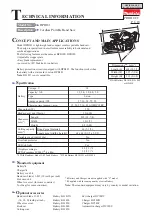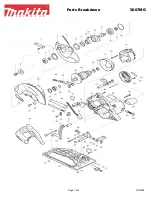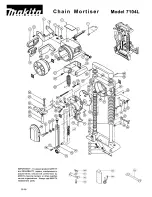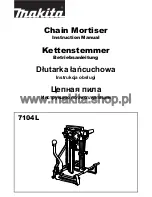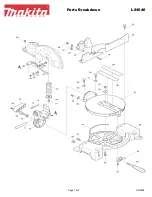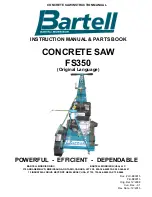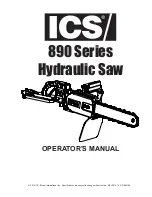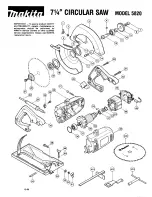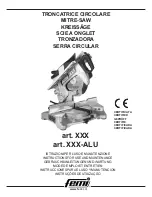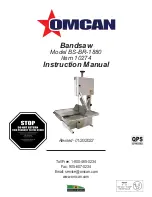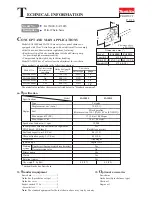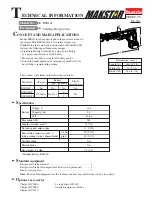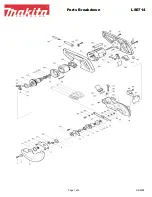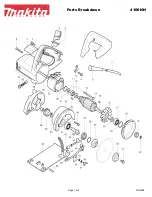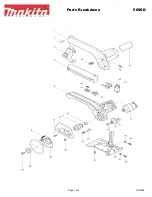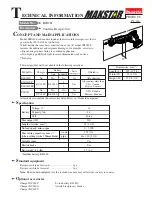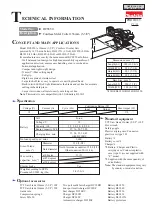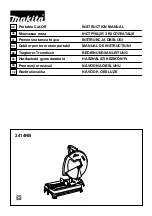
detenga por completo. Nunca
intente retirar la sierra del trabajo
ni tirar la sierra hacia atrás mientras
la hoja esté en movimiento o puede
haber un CONTRAGOLPE. Investigue
y tome acciones correctivas para
eliminar la causa del atascamiento
de la hoja.
3. Cuando reinicie una sierra en la
pieza de trabajo, centre la hoja de
la sierra en la entalla o corte y
verifique que los dientes de la sierra
no queden enganchados en el
material. Si la hoja de la sierra está
atascada, puede salirse o provocar
un CONTRAGOLPE desde la pieza de
trabajo mientras se reinicia la sierra.
4. Apoye bien los paneles grandes
para minimizar el riesgo de morder
la hoja y de CONTRAGOLPE. Los
paneles grandes tienden a curvarse
por su propio peso. Se deben
colocar apoyos a ambos lados
debajo del panel, junto a la línea de
corte y cerca del borde del panel.
5. No utilice hojas desafiladas ni
dañadas. Las hojas desafiladas o en
mal estado producen que la entalla
se angoste causando fricción
excesiva, atascamiento de la hoja y
CONTRAGOLPE.
6. La profundidad de la hoja y las
palancas que bloquean el ajuste del
corte en diagonal deben estar
ajustadas y seguras antes de hacer
el corte. Si el ajuste de la hoja se
mueve durante el corte, puede
provocar atascamiento y
CONTRAGOLPE.
7. Tenga extremo cuidado al hacer un
“corte de bolsillo” en paredes
existentes u otras áreas ciegas. La
hoja que sobresale puede cortar
objetos que pueden causar
CONTRAGOLPE.
8. Fije la profundidad de corte para no
más de 1/8" a 1/4" más del grosor
del material. Cuanto menos hoja
quede expuesta, habrá menos
probabilidades de atascamiento y
CONTRAGOLPE. Antes de cortar,
asegúrese de que los ajustes de
profundidad y de corte en diagonal
estén firmes.
9. Tenga cuidado con los materiales
inclinados, nudosos, húmedos o
deformados. Es muy probable que
estos materiales creen condiciones
de mordida y posiblemente
CONTRAGOLPE. No rasgue madera
deformada. Evite cortar clavos.
10. Use una guía de corte o guía para
borde al cortar. Las guías mejoran el
control y reducen el atascamiento
de las hojas.
11. Manténgase alerta. Cualquier
distracción puede provocar que la
hoja se tuerza o se atasque. Los
cortes repetitivos pueden llevar al
usuario a tener movimientos
descuidados.
FUNCIONAMIENTO GENERAL
Siempre sujete la pieza de trabajo en
forma segura en un caballete de
aserrar o banco.
1. Dibuje una línea de corte. Coloque
la parte delantera de la zapata
sobre el borde de la pieza de trabajo
sin hacer contacto con la hoja.
Sostenga el mango con una mano y
el mango delantero con la otra.
2. Alinee la línea de la vista con su
línea de corte. Coloque los brazos y
el cuerpo para resistir el
CONTRAGOLPE.
3. Para encender la sierra, presione el
botón de bloqueo hacia abajo
mientras tira del gatillo. Permita
que el motor alcance la velocidad
máxima antes de empezar a cortar.
4. Mientras esté cortando, mantenga
la zapata plana contra la pieza de
trabajo y sostenga con firmeza. No
fuerce la sierra a través de la pieza
de trabajo. Forzar una sierra puede
causar un CONTRAGOLPE.
5. Si está haciendo un corte parcial,
reiniciando en la mitad del corte o
corrigiendo la dirección, permita
que la hoja se detenga por
completo. Para volver a cortar,
centre la hoja en la entalla, retire la
sierra del borde de corte unas
pulgadas, y presione el botón de
bloqueo hacia abajo mientras tira
del gatillo y vuelve a retomar el
corte lentamente.
6. Si la sierra se atasca y se detiene,
manténgala agarrada con firmeza y
libere el gatillo de inmediato.
Sostenga la sierra sin moverla en la
pieza hasta que la hoja se detenga
por completo.
7. Después de terminar un corte,
asegúrese de que la protección
inferior se cierre y la hoja se
detenga por completo antes de
bajar la sierra.
Guía láser
La luz láser puede causar una
lesión grave en el ojo. NUNCA
mire directamente al rayo láser. No
apunte a otras personas ni animales
con el rayo láser.
La guía láser le muestra una línea de
corte que se extiende por la pieza de
trabajo incluso sobre los residuos.
Enciéndala y apáguela usando el
interruptor. Encienda el láser antes de
comenzar a serrar, apague el láser
cuando haya terminado de cortar para
preservar la vida de las pilas.
Para reemplazar las pilas del láser,
quite el tornillo de la tapa del
compartimiento de las pilas. Quite las
pilas viejas. Reemplácelas por dos pilas
nuevas (no mezcle pilas nuevas y
viejas). Vuelva a colocar la tapa en el
compartimiento. Apriete el tornillo.
Corte de paneles y tablas
Los paneles grandes y las tablas largas
se curvan o doblan si no están
sujetados correctamente. Si intenta
cortar sin nivelar ni sujetar la pieza de
trabajo correctamente, la hoja tenderá
a atascarse, provocando un
CONTRAGOLPE. Sujete los paneles
grandes. Asegúrese de definir la
profundidad del corte para que
solamente pueda cortar a través de la
pieza de trabajo, no a través de los
soportes.
Serrado
Serrar es cortar a lo largo siguiendo la
veta. Seleccione la hoja adecuada para
su trabajo. Use una guía de corte para
cortes a lo largo de 4" de ancho o
menos. Para instalar la guía de corte,
deslice la barra a través de la ranura de
la guía de corte a cualquiera de los
lados de la zapata. El ancho del corte
es la distancia desde el interior de la
hoja hasta el borde interior de la guía
de corte.
!
PRECAUCION
21 Sp
DG411200CK
Operation
(Cont’d.)
Do not attempt to remove cut material
when blade is moving. Always switch off
tool and wait for blade to come to a
complete stop before attempting to
remove debris from the work area.
Check lower guard for proper closing
before each use. Do not operate saw if
lower guard does not move freely and
close instantly. Never clamp or tie the
lower guard into the open position. If
saw is accidentally dropped, lower
guard may be bent. Raise the lower
guard only with the Lower Guard Lift
Lever and make sure it moves freely
and does not touch the blade or any
other part, in all angles and depths of
cut.
Check the operation of the lower
guard spring. If the guard and the
spring are not operating properly, they
must be serviced before use. Lower
guard may operate sluggishly due to
damaged parts, gummy deposits, or a
buildup of debris. Unplug the tool.
Periodically remove the blade, clean
the upper, lower guards and the hub
area with kerosene and wipe it dry, or
blow it clean with compressed air.
Lower guard should be retracted
manually only for special cuts such as
“Pocket Cuts” and “Compound Cuts”.
Raise lower guard by Lower Guard Lift
Lever. As soon as blade enters the
material, lower guard must be
released. For all other sawing, the
lower guard should operate
automatically.
NEVER hold piece being cut in your
hands or across your leg. It is
important to support the work
properly to minimize body exposure,
blade binding, or loss of control.
CAUSES AND USER PREVENTION
OF KICKBACK:
KICKBACK is a sudden reaction to a
pinched, bound or misaligned saw
blade, causing an uncontrolled saw to
lift up and out of the workpiece
toward the operator.
When the blade is pinched or bound
tightly by the kerf, or cutting slot,
closing down, the blade stalls and the
motor reaction drives the unit rapidly
back toward the operator.
If the blade becomes twisted or
misaligned in the cut, the teeth at the
back edge of the blade can dig into the
top surface of the wood causing the
blade to climb out of the kerf and jump
back toward operator.
KICKBACK is the result of tool misuse
and/ or incorrect operating procedures
or conditions and can be avoided by
taking proper precautions as given
below:
1. Maintain a firm grip with both
hands on the saw and position your
body and arm to allow you to resist
KICKBACK forces. KICKBACK forces
can be controlled by the operator, if
proper precautions are taken.
2. When blade is binding, or when
interrupting a cut for any reason,
release the trigger and hold the saw
motionless in the material until the
blade comes to a complete stop.
Never attempt to remove the saw
from the work or pull the saw
backward while the blade is in
motion or KICKBACK may occur.
Investigate and take corrective
actions to eliminate the cause of
blade binding.
3. When restarting a saw in the
workpiece, center the saw blade in
the kerf, or cut, and check that saw
teeth are not engaged into the
material. If saw blade is binding, it
may walk up or KICKBACK from the
workpiece as the saw is restarted.
4. Support large panels to minimize
the risk of blade pinching and
KICKBACK. Large panels tend to sag
under their own weight. Supports
must be placed under the panel on
both sides, near the line of cut and
near the edge of the panel.
5. Do not use dull or damaged blades.
Unsharpened or improperly set
blades produce narrow kerf causing
excessive friction, blade binding and
KICKBACK.
6. Blade depth and bevel adjusting
locking levers must be tight and
secure before making cut. If blade
adjustment shifts while cutting, it
may cause binding and KICKBACK.
7. Use extra caution when making a
“Pocket Cut” into existing walls or
other blind areas. The protruding
blade may cut objects that can
cause KICKBACK.
8. Set the depth of cut for no more
than 1/8" to 1/4" greater than the
thickness of the stock. The less
blade exposed, the less chance of
binding and KICKBACK. Before
cutting, be sure depth and bevel
adjustments are tight.
9. Be cautious of pitchy, knotty, wet or
warped stock. These are most likely
to create pinching conditions and
possible KICKBACK. Do not rip
warped lumber. Avoid cutting nails.
10. Use a rip fence or edge guide when
ripping. Guides improve control and
reduce blade binding.
11. Stay alert. Any distraction can cause
twisting or binding. Repetitive cuts
may lull the user into careless
movements.
GENERAL OPERATION
Always clamp the work piece securely
on a saw horse or bench.
1. Draw a cutting line. Place the front
of the shoe on the edge of the
workpiece without making blade
contact. Hold the handle with one
hand and the front handle with the
other.
2. Line up the sight line with your
cutting line. Position your arms and
body to resist KICKBACK.
3. To start the saw, push the lock-off
button down while pulling the
trigger. Allow the motor to reach
full speed before beginning cut.
4. While cutting, keep the shoe flat
against the workpiece and maintain
a firm grip. Do not force the saw
through the workpiece. Forcing a
saw can cause KICKBACK.
5. If making a partial cut, restarting in
midcut or correcting direction,
allow the blade to come to a
complete stop. To resume cutting,
center the blade in the kerf, back
the saw away from cutting edge a
few inches, push the lock-off button
down while pulling the trigger and
re-enter the cut slowly.
4
www.chpower.com
Operating Instructions and Parts Manual
Funcionamiento
(Continuación)













